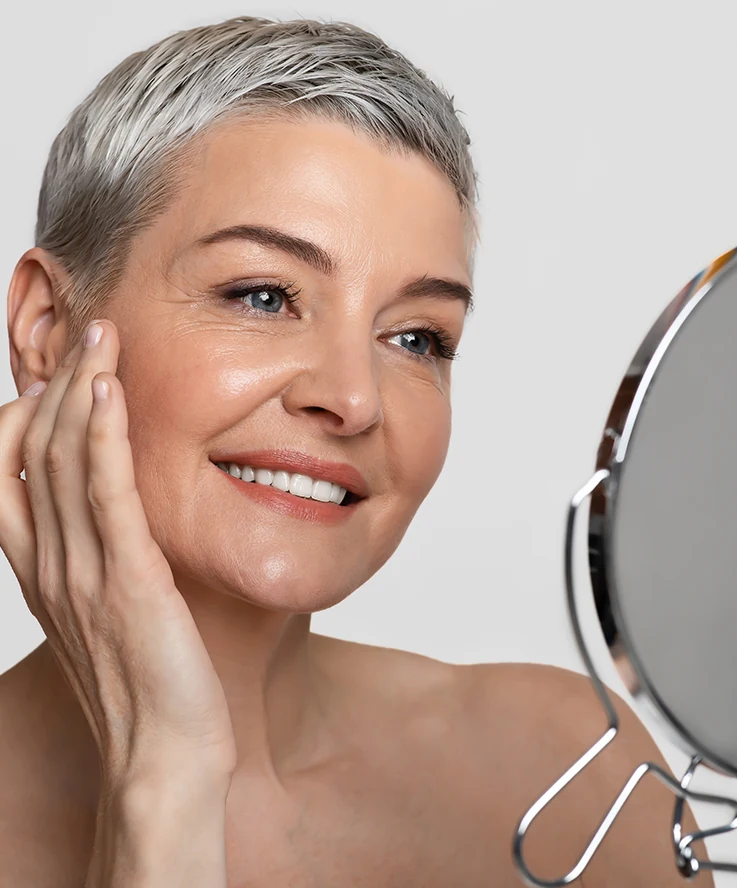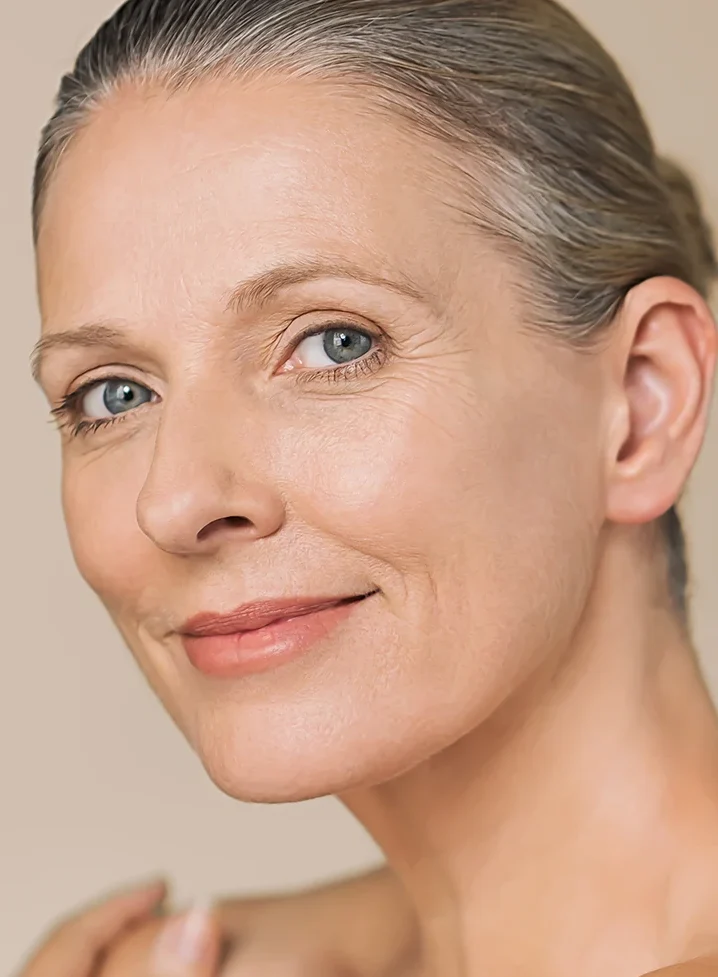
Eyelid Surgery (Blepharoplasty)
The eyes are a crucial aspect of facial communication and expression, and they are also one of the first areas of the face to show signs of aging. Over time, skin in the eye region becomes lax and loose, fat around the eyes tends to fluctuate, and the quality of skin and the supporting structures underneath begin to change. This results in droopy excess skin, puffiness, dark circles, and other changes that can impart a look of premature aging or weariness. Blepharoplasty, also known as eyelid lift surgery, is a transformative cosmetic procedure that addresses these aging symptoms. By lifting and refining the skin of both the upper and lower eyelids, it restores a more vibrant and youthful appearance.
For those troubled by sagging eyelids, puffiness, or dark circles, Dr. Stafford Broumand at 740 Park Plastic Surgery brings a wealth of expertise and innovative techniques to this specialized area of facial rejuvenation. Serving the diverse needs of patients across New York City, NYC, and Manhattan, Dr. Broumand is committed to offering personalized upper and lower eyelid surgery solutions, tailored to rejuvenate and enhance the eye area.
What is Blepharoplasty?
Blepharoplasty, commonly referred to as eyelid surgery or eyelid lift, is a plastic surgery procedure aimed at improving the appearance of the eyelids. It can be performed on the upper lids, lower lids, or both, depending on the patient’s needs. During eyelid surgery, excess skin and fat are removed from the upper and/or lower eyelids, and the underlying muscles are tightened to create a more refreshed and youthful appearance.
Trusted Source
Blepharoplasty
Mayo Clinic
Go to Source
Upper Blepharoplasty
Upper eyelid surgery is performed to reduce signs of aging to the upper eyelids. During this procedure, baggy excess skin is trimmed away, excess fat is removed or repositioned, and the muscles under the eyelids are tightened.
While most frequently performed as a cosmetic surgery procedure, blepharoplasty can also offer significant functional benefits for patients whose field of vision is interrupted by droopy eyelids (ptosis).
Lower Blepharoplasty
Lower eyelid surgery addresses the lower eye area to reduce signs of aging, such as under eye bags, dark circles, and puffiness. During this procedure, excess fat and skin are removed, rejuvenating the appearance of the lower eyelids.


Benefits of Eyelid Surgery
The benefits of eyelid surgery can be both cosmetic and functional:
- Reduced sagging or drooping of eyelids
- Improved appearance of undereye bags and puffiness
- A more refreshed, alert, youthful appearance
- Improved peripheral vision
- Improved self-confidence
- A short procedure with quick recovery and long-lasting results
- Minimal scarring
Who is a Candidate for Blepharoplasty?
The most common reasons patients request blepharoplasty include:
- Droopy eyelid skin
- Under eye bags and puffiness
- Dark circles under the eyes
- Hooding of the upper eyelids that may or may not obstruct the visual field
- Excess fat or skin in the eyelid area
In general, a good candidate for blepharoplasty:
- Is in good overall health
- Does not have serious eye conditions or thyroid disorders
- Does not smoke
- Has realistic expectations about what can be achieved through eyelid lift surgery
Trusted Source Who is a good candidate for eyelid surgery? American Society of Plastic Surgeons Go to Source

Preparing for Eyelid Surgery
Preparing for eyelid surgery is a key step towards achieving your aesthetic goals. During your initial consultation, Dr. Broumand will discuss your expectations and evaluate whether you are a good candidate for eyelid surgery. It’s important to share your complete medical history, current medications, and any past facial surgeries or treatments at this time.
As part of your preparation, an eye exam is required to ensure the best possible outcome from your blepharoplasty. Dr. Broumand will also provide specific preoperative instructions, which may include stopping certain medications or supplements to reduce the risk of bleeding. To aid in your recovery, it’s advised to avoid smoking and alcohol before the surgery.
Additionally, make arrangements for someone to drive you home post-surgery and assist you during the early stages of recovery. Following these guidelines and closely following Dr. Broumand’s advice will contribute to a successful eyelid surgery experience at 740 Park Plastic Surgery in NYC.

The Blepharoplasty Procedure
Blepharoplasty surgery is an outpatient procedure that may be performed under general anesthesia or local anesthesia with sedation, depending on the extent of the surgery. Incisions for an upper eyelid lift are strategically placed in the natural creases of the upper eyelids. For lower lid blepharoplasty, Dr. Broumand will create incisions just below the lash line or inside of the lower eyelids. Next, Dr. Broumand will meticulously remove excess skin, fat, and muscle from the eyelids. In some cases, fat may be repositioned to improve the overall shape and appearance of the eyelids. Once Dr. Broumand is satisfied with the results, he will close the incisions using very fine sutures.
Following blepharoplasty surgery, some initial swelling and/or bruising in the eyelid region is to be expected. These symptoms should gradually dissipate with time. Any potential discomfort can generally be controlled with medication, and the majority of patients are able to return to non-strenuous work and/or daily activities within approximately five to seven days. In order to help ensure proper healing, Dr. Broumand will apply a prescription cream and/or eye drops immediately after surgery, and they recommend avoiding any rigorous physical activity for at least several weeks.
Most of our patients begin to see the results of their eyelid lift within a few weeks of their surgery. The final results are visible when swelling and bruising have resolved, typically within three to six months.
What is the right age for eyelid surgery?
There is no “right” age for eyelid surgery. For some people, signs of aging in the eye area don’t present until they are in their 60s; for others, this could happen much earlier. If you are unhappy with the appearance of your eyes due to baggy skin, puffiness, and/or dark circles, you may be ready to consider blepharoplasty.
Will I have scars after my eyelid lift?
Dr. Broumand is meticulous in placing blepharoplasty incisions in areas where they are hidden in the upper and/or lower eyelid crease. You should have no visible scarring after your eyelid surgery.
How much does eyelid surgery cost?
The cost of eyelid surgery is unique to each patient’s treatment plan. For patients experiencing ptosis or droopy eyelid skin that impacts their vision, functional blepharoplasty may be covered by insurance.
How long is recovery time after eyelid lift surgery?
Healing time varies by patient. Most of our patients feel comfortable going back to work within one week of their eyelid lift, though Dr. Broumand will recommend that patients wait longer before engaging in strenuous activity.
What are the risks of blepharoplasty?
Eyelid surgery is considered to be safe, especially when performed by an experienced and board-certified plastic surgeon such as Dr. Stafford Broumand. Still, there are risks and complications associated with every surgical procedure. The most common possible complications of blepharoplasty include:
- Bleeding
- Infection
- Visible scarring
- Dry eye
Very rare risks associated with blepharoplasty include:
- Inability to close the eyes
- An upper lid or lower lid that folds inward or outward
- A lower lash line that appears pulled down
Trusted Source Eyelid Surgery (Blepharoplasty) Cleveland Clinic Go to Source
Can I combine my eyelid lift with other procedures?
Yes. For more comprehensive facial rejuvenation, patients may wish to combine their eyelid lift with a facelift, brow lift, or even non-surgical treatments such as BOTOX™ or dermal fillers. Dr. Broumand can help you develop the ideal treatment plan to help you achieve your cosmetic goals during your consultation.
Schedule A Consultation for Eyelid Surgery
Explore the exceptional expertise of Dr. Broumand at 740 Park Plastic Surgery, located in the vibrant heart of New York City, for your eyelid lift surgery. Renowned for his meticulous technique and tailored approach, Dr. Broumand specializes in rejuvenating a patient’s experience in a way that naturally complements their natural beauty. Our state-of-the-art and private facilities offer the perfect setting for your eyelid surgery. Contact us to schedule a confidential consultation with Dr. Broumand to discuss how we can achieve your specific vision for eyelid enhancement.

1 Mayo Clinic. Blepharoplasty. Available: https://www.mayoclinic.org/tests-procedures/blepharoplasty/about/pac-20385174. Accessed January 2, 2024.
2 American Society of Plastic Surgeons. Who is a good candidate for eyelid surgery? Available: https://www.plasticsurgery.org/cosmetic-procedures/eyelid-surgery/candidates. Accessed January 2, 2024.
3 Cleveland Clinic. Eyelid Surgery (Blepharoplasty). Available: https://my.clevelandclinic.org/health/treatments/8409-eyelid-surgery-blepharoplasty. Accessed January 2, 2024.
Dr. Stafford Broumand has reviewed and approved this content.
Page Updated:





